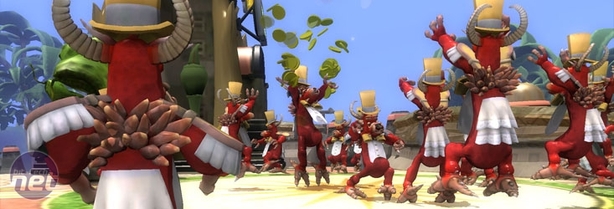
Adventure Game
I’ve heard it said that music journalists are people who want to be rock stars but never had the talent to learn an instrument and that, by extension, games journalists are usually people who want to be game designers but who lack the maths skills. It’s a view I generally agree with, especially after all my failed and half-hearted attempts at game creation.Making games is hard work and, as technology ploughs on, it’s getting harder. By this stage it's hard to even conceive how most games get started. That makes the prospect of creating small self-contained adventures in Spore sound a bit too good to be true – it’s either going to be too hard, or not complex enough, right?
Amazingly though, the adventure creator that Maxis has designed for Spore Galactic Adventures doesn’t seem to be either. It’s both simple enough for most people to pick up and play, but robust enough to allow some semi-decent quests with branching plots and everything.
Much of this is down to the fact that the quests, which are presented to players as missions they can undertake in the Space-game by assembling away teams and landing on planets, have been stripped down to only the essentials. Essentially all players are offered is a skeleton and a number of materials to dress it in.
To start with, players can design the planet they want to use – design one properly that is, not just up the heat and so on. You can properly terraform the environment, sprinkling fjords all over the place like a young Slartibartfast and making the world cooler than MC Hammer’s pocketwatch if you want to. You can ever have entire water-worlds or deserts if that’s more your speed.
Once the world has been developed you can zoom in and start to litter it with content, either creating your own aliens and items for the job or pulling them from the Sporepedia. There are more than 64 million different bits of content uploaded to the central Sporepedia now and only half of them look rude, so there’s no shortage of props.
After you’ve set the scene with a few aliens and a smattering of cities then it’s time to start filling those occupants with something else – purpose! The adventure editor is mostly text driven when it comes to dialogue, but you’re not just limited to providing your actors with lines in your effort to make them into performing monkeys, you can also add certain behaviours.
The behaviours on offer do admittedly seem a little simplistic at first – you can toggle specific aliens to be friendly, aggressive, cowardly and so on – but as time goes on you learn to use these tools more effectively and in conjunction with the other tools. You can set patrol routes or have actors wander aimlessly, you can have them track other animals and set up food-chains and so on, combining these actions with text and behaviours to create certain effects.
Next, comes the objectives. It is possible to create adventures which are objectiveless and totally free-roaming...but what’s the point?
There are a wide range of objectives that can be added into your missions – you can task players with having to recruit, kill, befriend, capture, find, eat, destroy, defend and so on, but in our opinion the real magic lies in the use of IF and OR commands. Using these you can create branching paths to your adventure – saying that you should either kill the bunny or protect it, for example. If you killed it then you might get a prize, if not then not.
Even without branching paths however, it’s still possible to create some very interesting situations in the game. Using patrol paths and Defend objectives, plus a simple timer and foodchain you can create a situation where players have to defend an alien as it moves through the landscape, constantly besieged by enemies. That’s a situation where the new ray-guns and equipment will certainly come in handy...

MSI MPG Velox 100R Chassis Review
October 14 2021 | 15:04











Want to comment? Please log in.